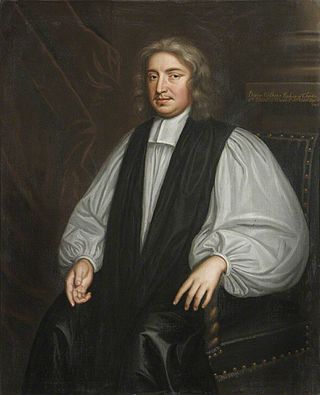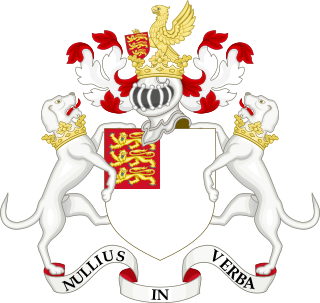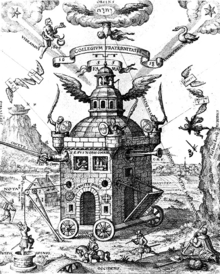
Sir Christopher WrenFRS was an English architect, astronomer, mathematician and physicist who was one of the most highly acclaimed architects in the history of England. Known for his work in the English Baroque style, he was accorded responsibility for rebuilding 52 churches in the City of London after the Great Fire in 1666, including what is regarded as his masterpiece, St Paul's Cathedral, on Ludgate Hill, completed in 1710.

John Wilkins was an Anglican clergyman, natural philosopher, and author, and was one of the founders of the Royal Society. He was Bishop of Chester from 1668 until his death.
Samuel Hartlib or Hartlieb was a Royal Prussian born, English educational and agricultural reformer of German-Polish origin who settled, married and died in England. He was a son of George Hartlib, a Pole, and Elizabeth Langthon, a daughter of a rich English merchant. Hartlib was a noted promoter and writer in fields that included science, medicine, agriculture, politics and education. He was a contemporary of Robert Boyle, whom he knew well, and a neighbour of Samuel Pepys in Axe Yard, London, in the early 1660s. He studied briefly at the University of Cambridge upon arriving in England.

The Royal Society, formally The Royal Society of London for Improving Natural Knowledge, is a learned society and the United Kingdom's national academy of sciences. The society fulfils a number of roles: promoting science and its benefits, recognising excellence in science, supporting outstanding science, providing scientific advice for policy, education and public engagement and fostering international and global co-operation. Founded on 28 November 1660, it was granted a royal charter by King Charles II as The Royal Society and is the oldest continuously existing scientific academy in the world.
Benjamin Worsley (1618–1673) was an English physician, Surveyor-General of Ireland, experimental scientist, civil servant and intellectual figure of Commonwealth England. He studied at Trinity College, Dublin, but may not have graduated.

Theodore Haak was a German Calvinist scholar, resident in England in later life. Haak's communications abilities and interests in the new science provided the backdrop for convening the "1645 Group", a precursor of the Royal Society.

Ralph Bathurst, FRS was an English theologian and physician.
Matthew Wren was an English politician and writer. He is now known as an opponent of James Harrington, and a monarchist who made qualified use of the ideas of Thomas Hobbes.
Chelsea College was a polemical college founded in London in 1609. This establishment was intended to centralize controversial writing against Catholicism, and was the idea of Matthew Sutcliffe, Dean of Exeter, who was the first Provost. After his death in 1629 it declined as an institution.

New College, Durham, or Durham College, was a university institution set up by Oliver Cromwell, to provide an alternative to the older University of Oxford and University of Cambridge. It also had the aim of bringing university education to Northern England.
John Beale was an English clergyman, scientific writer, and early Fellow of the Royal Society. He contributed to John Evelyn's Sylva, or A Discourse of Forest-Trees and the Propagation of Timber, and was an influential author on orchards and cider. He was also a member of the Hartlib Circle.
The Hartlib Circle was the correspondence network set up in Western and Central Europe by Samuel Hartlib, an intelligencer based in London, and his associates, in the period 1630 to 1660. Hartlib worked closely with John Dury, an itinerant figure who worked to bring Protestants together.
During the early part of the 17th century, and persisting in some form into the early 18th century, there were a number of proposals for an English Academy: some form of learned institution, conceived as having royal backing and a leading role in the intellectual life of the nation. Definite calls for an English Academy came in 1617, based on the Italian model dating back to the 16th century; they were followed up later, after the 1635 founding of the French Académie, by John Dryden (1664), John Evelyn (1665), and Daniel Defoe (1697).
Gerard Boate was a Dutch physician, known for his Natural History of Ireland.

The Gresham College group was a loose collection of scientists in England of the 1640s and 1650s, a precursor to the Royal Society of London. Within a few years of the granting of a charter to the Royal Society in 1662, its earlier history was being written and its roots contested. There is still some debate about the effect of other groups on the way the Royal Society came into being. The composition of those other groups is unclear in parts; and the overall historiography of the early Royal Society is still often regarded as problematic. But this group has always been seen as fundamental to the course of events.
Katherine Jones, Viscountess Ranelagh, also known as Lady Ranelagh, was an Anglo-Irish scientist in seventeenth-century Britain. She was also a political and religious philosopher, and a member of many intellectual circles including the Hartlib Circle, the Great Tew Circle, and the Invisible College. Her correspondents included Samuel Hartlib, Edward Hyde, William Laud, Thomas Hyde, and John Milton. She was the sister of Robert Boyle and is thought to have been a great influence on his work in chemistry. In her own right, she was a political and social figure closely connected to the Hartlib Circle. Lady Ranelagh held a London salon during the 1650s, much frequented by virtuosi associated with Hartlib.
William Rand was an English physician who projected general reforms in medical education, practice and publication. His views were Paracelsian and Helmontian, and he participated in the Hartlib Circle.

Thomas Henshaw (1618–1700) was an English lawyer, courtier, diplomat and scientific writer. While not a published alchemist, he was a significant figure in English alchemical work from the 1650s onwards; he is known to have used the pen-name "Halophilus".
Arnold Boate, originally called de Boot (1606–1653) was a Dutch physician, writer and Hebraist who spent much of his life abroad, and lived for several years in Dublin. There he married Margaret Dongan, a judge's daughter, whom he portrayed lovingly in his book The Character of a Truly Virtuous and Pious Woman. He was the brother of Gerard Boate, author of The Natural History of Ireland, for which Arnold supplied much of the material. Both Gerard and Arnold were members of the Hartlib circle.
Dorothy Durie or Dorothy Dury (1613–1664), born Dorothy King, first married name Dorothy Moore (c.1618–1645), was an Anglo-Irish writer on education. She had a talent for languages and she was interested in the education of women, in alchemy and in the study of medicine.








